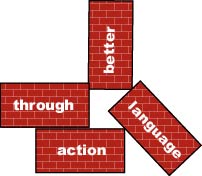 |
|

Ioana Goga's PhD researchConeural > Ioana Goga > PhD research
Educating attention in cognitive robotsOne obvious source of inspiration for building integrated, artificial systems that can scale both the size and complexity of their behavioral repertoire is the process of human cognitive development. The rapprochement of developmental and social psychology, robotics, and neuroscience has given birth to several research fields: epigenetic robotics (Zlatev and Balkenius, 2001), cognitive robotics (Weng et al., 2000), social robotics (Billard and Dautenhahn, 2000). In this thesis, we will follow a developmental approach to study the mechanisms by which human infants acquire goal-directed behavior and language and to investigate how to develop similar competences in robots. The focus will be on investigating how interactive teaching, based on tutoring and demonstration can be implemented in robots. Learning by imitation has many of the desirable characteristics of animal-like,
online learning, and endows the robot with the capacity to continually learn
new behaviors while observing and interacting with other agents (Demiris and
Hayes, 2001). In order to assist the imitator in recognizing the goal of the
demonstration and in structuring the imitation behavior, the teacher can use
instruction. In learning by instruction the agent is given information
about the environment, domain knowledge, or about how to accomplish a particular
task on-line. There is recent interest in the field, towards collaborative learning
based on joint intention and progressive tutoring of the learner (Breazeal et
al., 2004). The novelty of our approach results from the investigation of the imitation and tutoring mechanisms from an integrative perspective. Both can be seen as building blocks of a general bootstrapping mechanism, which uses all available means to focus attention, extract a bit of knowledge, and use this knowledge to perform little more analysis on future inputs, and thereby, reduce the uncertainty. The model starts with a set of pre-programmed behaviors (i.e., gaze following, skin color preference, visuomotor coordination, grasping abilities) and develops in an incremental manner goal-directed behavior, intentionality and language. We refer to this bootstrapping process based on demonstration and tutoring as a process of educating attention in cognitive robots.
Figure 1. My PhD research plan. The yellow activity flow has been accomplished, while the white boxes are under development. Click on any box on the graphic, to see details on the related activities. Preliminary work has been carried out towards the design of a cognitive architecture, which can support learning by imitation and instruction (Goga and Billard, 2004). An essential component of the cognitive architecture is represented by the attention module, whose function is to direct gaze towards objects of interest in the environment. A two-component framework for attention deployment has been implemented, inspired by recent research in modeling of visual attention (Goga and Billard, 2006). An important tenet of this thesis research is that it builds on real data from psychological, developmental and neurobiological studies. The starting point is represented by the definition of a developmental benchmark, against which modeling can be compared. A good candidate is the seriated nesting cups task (Greenfield et al., 1972). Preliminary work focused on investigating with modeling and experimental methods the various types of constraints (i.e., social, computational and maturational) involved in the performance of the seriated nesting cups task (Goga and Billard, in press). The outcome of these computer simulation investigations is represented by a developmentally constrained model able to reproduce the limitations observed in the human infants' strategies (Goga and Billard, in press). We intend to refine and extend the action system currently developed for the imitation of the seriated nesting cups task towards the integration with a language system capable to learn from instruction. Accomplished and expected results:
|
|||||||||||||||||||||||||||||||||||||||||||||||||||||